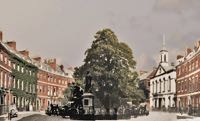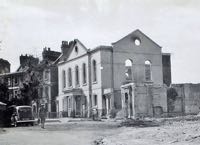
Bedford Circus and Bedford Street
Page updated 20th June 2018
 Bedford Street
Bedford Street
Large parts of mediaeval Exeter, within the walls, belonged to the King, the Church or to rich citizens. The north west section was largely owned by St Nicholas Priory, the southern part by the Cathedral, the north east was Northernhay Castle while the eastern quarter, was a Dominican Friory, known as the Black Friars. The friory itself, dating from the 13th century was situated at a spot which became the junction of Bluecoat Lane and Bedford Street, before they were swept away in the redevelopment during 2005; it now lies beneath the new Debenhams.
At the Reformation in the 1530's, the priory was closed and acquired by Lord John Russell, the Duke of Bedford. In 1539 he had the building converted into a private house which became known as Bedford House. Archaeology indicates that it consisted of two sides of the old friary in an L shape, named Bedford Square.
A hundred or so years later, in this house during the siege of Exeter in the Civil War on 16th June 1644, that the wife of Charles I, Queen Henrietta Maria gave birth to her ninth child, Princess Henrietta Anne. On the 14th July, 1644 the Queen fled to Falmouth to board a ship to France and exile. The baby princess remained in Exeter, in the care of Lady Dalkeith - when Exeter fell to the Parliamentarians in 1646, she was allowed to proceed to France with the child, as part of the surrender terms.
After the Civil War, Bedford House was divided into tenements and went into a period of slow decline. In 1769, the Duke of Bedford negotiated a peace treaty with the French, which allowed them to import silk into the country. Exeter wool merchants thought the competition from silk would affect their trade. The Duke came to Exeter to be bestowed the freedom of the city from the Mayor and civic authorities at the Guildhall–the merchants who were waiting outside became rebellious towards the Duke's presence. The Mayor tried to remove the Duke to Rougemont Castle but was prevented by the mob and he had to take refuge in Bampfylde House, away from the baying crowd–this prompted the Duke to sever all ties with the city and order that Bedford House be demolished.
Bedford Circus
In the 1770's a building boom was in full swing in Exeter. Plans were drawn up by Robert Stribling to redevelop the area around the Bedford House site for a small elliptical circus lined with grand houses. In 1773, the building of Bedford Circus started with the first 14 houses and a gap made in the city wall to allow access to the new development.
Constructing the whole Circus was a long process and, not to be fully completed until 1825. The resultant development consisted of 13 Georgian houses facing another 9 opposite. The Bedford Chapel was in the centre of the block of nine houses. There was a small, elliptical, iron fenced green inside the access road around the front of the houses.
Activity in the Circus
A list of occupancy in the 1880s include the Devon and Exeter Savings Bank, adjoined by the Athenæum a hall for public meetings and lectures, opened in 1835. The offices of the Water Corporation, City Surveyor, Treasurer and Town Clerk occupied Stribling's fine buildings. The Dental Hospital, established in 1880 and the County Court Offices could also be found in the Circus. It was very much at the heart of Civic life.
In 1878, the bronze Deer Stalker Bronze statue, by E B Stephens was erected in the central park. Mounted on a granite pedestal, the whole was surrounded by an iron railing. In 1880, it was proposed to move the statue to London Inn Square, and to place Stephen's statue of Lord Courtenay in its place. There was a determined opposition to the site, and an alternative location in Northernhay Gardens, near Skinner's Lodge was proposed, and the statue was moved, and replaced by a statue of Lord Courtenay MP, a member of an old Devon family.
In 1896, the first of the annual Horse Cart Parade finished its tour of the city in Bedford Circus. The prizes were awarded by Lady Iddesleigh, as the carts were paraded past an improvised platform containing Lord and Lady Poltimore, Lady Rosalind Northcote, Lady E Northcote (her mother), the Mayor Robert Pople, Colonel Leigh and Mr G F Gratwicke.
Destruction through fire
In the 20th century, as the living requirements of families changed, many of the houses became offices for insurance, banking, doctors and other services. During the last war, Bedford Circus had a shelter for 200 people installed on the central green. On 4th May 1942, the bombing of Exeter resulted in many destroyed buildings, including most of Bedford Circus. A report at the time said:
"Explosions from petrol tanks, etc, in Hughes Garage blew up burning debris, which was carried by the wind, on to Bedford Circus and set alight several properties there."
A large bomb also fell on the Devon and Exeter Bank at the north west side of the Circus, killing seven Home Guard, sheltering in the basement.
Bedford Street
Up until 1877, Bedford Street was a narrow affair, similar to the modern Martins Lane, and only suitable for pedestrians. It was widened in that year, into a fine street joining the High Street and Southernhay, and incorporating Bedford Circus. The Devon and Exeter Constitutional Conservative Club occupied a new building on the north side of the street, between Catherine and High Street, while Ellis Dupree and Tucker, silversmiths occupied the southern building. In 1912, Lloyds Bank was built on the corner of the High Street, on the south side of Bedford Street, and in 1916, the wonderful Dellers Cafe was built to the rear and over the top of the bank.
The first Dental Hospital of Exeter was opened at 15a Bedford Street. On the 16th June 1880, the Flying Post reported that the new Dental Hospital had opened for business the previous Monday. Five students were in attendance on the first day to assist the surgeons. The lease on the Bedford Circus premises ended in 1886.
After the blitz, many of the houses of Bedford Circus were burnt out, rather than collapsed and could have been saved, but the decision was taken by town clerk, Cyril Newman, to demolish the whole area and redevelop it, despite protestations of some of the owners. The start of the rebuilding was marked when Princess Elizabeth unveiled a plaque on 21st October 1949 at the head of what would become Princesshay. All she could see of the new shopping precinct were pegs in the ground, laying out the position of the street and buildings.
Bedford Street was realigned, and moved west a few metres and Princesshay built to intersect at right angles to give a view of the Cathedral. The Courtenay statue was moved to the top of Bedford Street, facing the High Street. The post-office, demolished in 2005, occupied much of what was the old Bedford Circus.
The Land Securities redevelopment has created yet another new Bedford Street which retains absolutely nothing of the old Bedford Street, either in reality nor in spirit.
Sources: British Civil War website, Exeter Local History Newsletter, September 2004, Lost Exeter and Exeter in the 1940s by Todd Gray, Exeter Past by Hazel Harvey, Exeter Burning by Peter Thomas, Exeter in Old Photographs by Peter Thomas, The Story of Exeter by A M Shorts plus varied guidebooks including Vincent's Guide to Exeter 1884. © 2016 David Cornforth
│ Top of Page │











